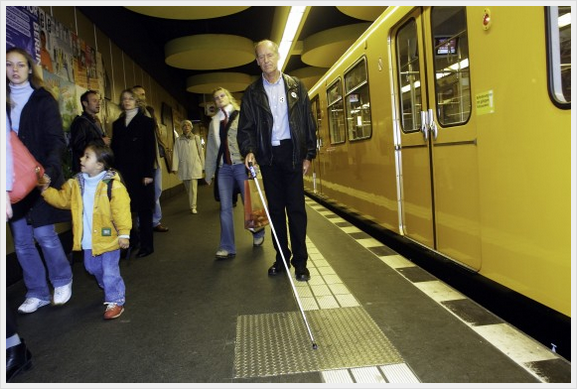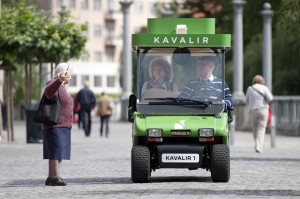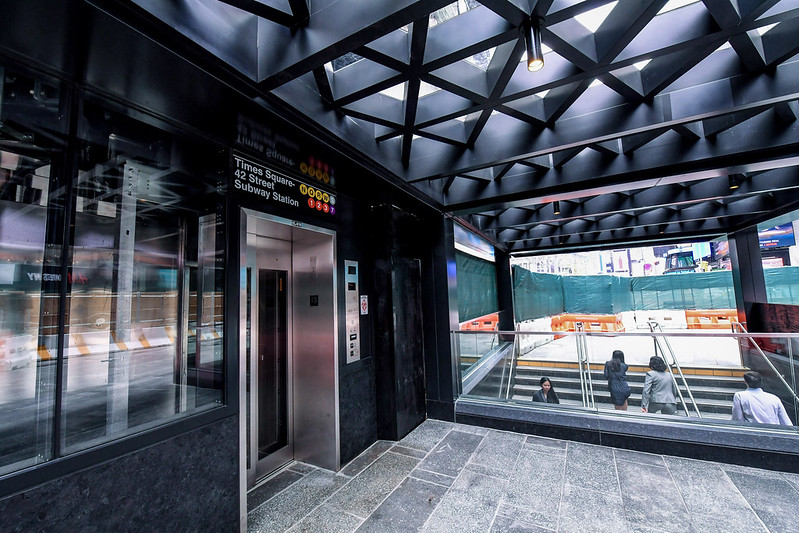
Photo: 000000000000000000000000000
Accessing a city’s full potential
25 April 2013
by Richard Forster
Cities can be obstacle courses that penalise the elderly and the disabled through poor urban planning but as Jonathan Andrews reports, those cities that improve such access can reap further benefits for all citizens.
The rising percentage of the world’s population living in urban areas is often quoted at conferences on cities–usually to a few groans from the audience who have heard it frequently before–but one statistic that isn’t so readily cited is that while cities are growing, their residents are growing older too.
The World Health Organisation (WHO) reports that the global population aged 60 will double from 11 percent in 2006 to 22 percent by 2050. Similarly WHO says that more than 1 billion people in the world have a disability. Putting this together means cities need to provide much better mobility and access for older and disabled residents and visitors.
“Almost everyone of us will be permanently or temporarily disabled at some point in life,” said Margaret Chan, WHO Director-General, speaking at WHO’s launch of the first World Report on Disability, in 2011. “We must do more to break the barriers which segregate people with disabilities.”
Within the European Union more than 80 million people have a mild to severe disability and in 2010, the European Commission launched the Access City Award to reward cities’ progress in increasing accessibility.
Berlin has just been presented with the 2013 Access City Award for its strategic and inclusive disability policy which has invested heavily in turning the former divided city into an accessible metropolis. Since 1992 Berlin has pursued a policy of making the city ‘barrier-free’, from the creation of a modern, accessible transport infrastructure, to the design of public buildings and spaces.

“The aim is to create equal mobility opportunities for all the city’s people,” says Ephraim Gothe, Permanent Secretary for Building and Housing of the Senate Department for Urban Development and the Environment, Berlin. “This applies particularly to elderly citizens and people with disabilities.”
The city is on target to achieve its own ambitious goals to make the city completely barrier-free by 2020. Already its bus fleet has achieved this with accessible ramps and low-floor design. Attention is now focused on installing lifts in all 173 underground stations and 132 above ground train stations. The city’s tram network will also be gradually updated with new low-floor rolling stock, set to be running by 2017.
Costs
Making big infrastructure improvements and buying new rolling stock doesn’t come cheap. Just the new trams alone will cost Berlin €461.9 million but Gothe believes improvements can begin with cost effective solutions.
Increasing the number of dropped kerbs, expanding pedestrianisation and accessible routes and paths, and installing tactile guidance systems for blind people at intersections and metro stations, are some low-cost improvements that cities can make.
“Starting with the pedestrian environment and sidewalks are really the best money you can invest in,” says Julie Babinard, Environmental and Social Development Specialist in transport at the World Bank, and also a technical advisor on the joint WHO/World Bank World Report on Disability. “A journey does not start once you are on the transport system. It starts from when you are leaving your home. Often what we have seen is you have a very flexible and high-end system but a person often may not even get to the ramp because cars are parked on the sidewalk and there are barriers to cross the road.”
Babinard says that cities should start with low-cost modifications: pedestrian crossings, visible signs, flat smooth footpaths and ramps with low angles. “Then at the other end of the spectrum you would have elevators in the metros, as they would probably be the most expensive improvements.”
Another inexpensive measure introduced by Berlin was to appoint a commissioner for people with disabilities and to host roundtable discussions on access to which disabled people were invited.
Multiple benefits
The availability of low-cost improvements is one argument lobbyists are making to get cities to adopt better access for the disabled and the elderly. Another is the benefit to the greater population that accessibility improvements can make.
“We see that with a lot of the improvements we are trying to implement they can also benefit multiple users,” adds Babinard. “You can help kids move around, mothers with strollers and bags, and help combat climate change as people will be more mobile, walk more and use public transport.”
In Ljubljana, Slovenia, the city has been quietly achieving its own goals in accessibility, winning the European prize for urban space in 2012 and coming runner-up for the 2012 Access City Award. In 2007, when Ljubljana created its 2025 vision for the city, Tjaša Ficko, the Deputy Mayor, recalls how the city hall didn’t even have a lift, but has since progressed rapidly.
Ficko believes a city that is friendly to vulnerable groups is friendly to all and that projects aimed at the disabled and elderly can also benefit other residents or visitors. “I have never heard of anyone complaining about things that are acquired in the city that are primarily intended for the elderly and people with disabilities,” says Ficko, explaining how the implementation of audio announcements in plain language on city buses, primarily designed for blind people, has also assisted tourists who are unfamiliar with the city.
At the same time, if the streets are more accessible, there is also a contribution to improving road safety. Before Ljubljana began pedestrianising its city centre, previously burdened with heavy traffic, the streets’ granite cobblestones were in such bad shape that many visitors complained of difficulties of walking around.
“Due to lower kerbs, ramped entrances and the simple fact that there isn’t vehicle traffic, it’s absolutely true that the city centre is a friendlier place for the most vulnerable groups in society,” adds Ficko. “Nowadays it is an oasis for socialising, where children can play peacefully and people can walk without feeling nervous.”
With many cities enthusiastically pedestrianising city streets and banning cars, Ficko reminds city leaders that the elderly and disabled still need to be catered for.

“It’s true that for some, especially the elderly, walking can sometimes be too demanding thus we have introduced two free electric vehicles into the pedestrian zone, known as Kavalirs,” she explains. “People can use them without any prior notification whenever they come across one in the street, but they can also be called for to collect people.” Two special taxis, adapted for people with disabilities, can also enter the pedestrian zone.
Guillaume Dufresne, Mobility and Transport Officer, European Disability Forum, says that by providing adequate transport access for all users, the socio-economic welfare of cities will increase. “Transport services must adapt to the needs of our rapidly ageing population in order to support longer working lives and independent living in old age, and thus reduce the impact of ageing on public budgets.”
Financial incentives
Regulation is one way of ensuring accessible transport options, including for taxis and other forms of urban transport. Tom Shakespeare, Technical Officer, WHO, and one of the World Report’s authors, believes that there is a market, and a financial incentive, to provide accessible transport.
“In the United Kingdom, it’s a two way thing, you need to have regulation that mandates it and taxis have to be accessible,” he explains. “Some taxi drivers complained about the onerous requirement to buy an accessible vehicle but there is equally as many people who say ‘Great, on a Saturday night I can fit eight people in this vehicle, so when a wheelchair user is not needing it, I’m making money’. In those scenarios it’s a win-win situation.”
Accessibility differs wildly between cities, with larger and wealthier cities more user friendly than cities in the developing world, where, according to Dufresne, it is more difficult to invest in public urban transport.
Not all is bad news for disabled and elderly in those cities, says Shakespeare. “I’m from Britain and I had underestimated how much other places were doing,” he says. “There are initiatives in Curitiba, Bogota, Quito, Dar es Salaam, and now in Beijing and Delhi which both have accessible metros. You realise that people are getting it, so that’s encouraging.”
In India, a country not known to Shakespeare previously for its accessible cities, he recalls even seeing a rickshaw being converted to provide wheelchair access. He believes that a key to increasing accessibility is being where the people are.

“It’s no use having an all seeing, all dancing, US$200,000 this that and the other, we have to have something that can be used in the slums,” he adds. “Because when we look at the evidence of the World Report, and when we talk and listen and read research from around the world, transport is the biggest barrier to people with disabilities.”
One development that has improved access tremendously for the elderly and the disabled has been the popularisation and success of Bus Rapid Transit (BRT) systems. “BRTs aren’t designed specifically for disabled people,” says Shakespeare. “They are designed for mass transit but it doesn’t have steps, or gaps, it has level access and ramps. It’s all smooth and level, so it’s that much easier for everyone.”
Airports too are routinely cited as best practice examples as they provide smooth and easy access for all. “I travel a lot through Heathrow and Gatwick [London airports], and it’s all step free,” says Shakespeare. “There are thousands of people travelling with suitcases, they’re tired and frustrated and you just want it to be easy. That ease makes my life as a wheelchair user simple too.”
One misconception is the belief that people with a disability are just people in a wheelchair. Providing accessibility is also about information and communication, signage, and making sure that older people, people who are blind or deaf, or who have intellectual disabilities, can navigate easily through cities.
With the economic crisis pinching city budgets, Dufresne from the European Disability Forum believes this in no way should be used as an excuse to remain inactive, as investments will unlock all citizens’ potential and bring future benefits. “With improved transportation people with disabilities will also gain greater access to education and to the employment market,” he adds. “Equal access to transportation and services in general is the prerequisite of future prosperity and the sustainable growth that cities pursue.”
Better information and training are essential
According to Guillaume Dufresne, European Disability Forum, the following can also contribute to improving journeys for disabled passengers:
- Staff training: training of staff is an essential condition to guarantee access to services. As regards urban transport, staff are not usually prepared for the problems experienced by a person with disabilities, which can lead to many misunderstandings between the two.
- Better reliability of the service: The fact that an urban train or bus is late or changes its route at the last minute is particularly detrimental for persons with disabilities, who often miss the information because it was not accessible to them.
- Innovation is also of major importance: Technology around ticketing and way-finding is becoming an important element of the transport system, but with the increasing use of automatised equipment, there is a risk of excluding persons with disabilities. This risk can be avoided with innovative technologies for ticketing and way-finding to facilitate the transport journey of persons with disabilities.
- Enforcement: without an adequate enforcement mechanism and monitoring system involving the disability movement, as well as simplified and accessible complaint handling procedures, cities will never be capable of delivering full accessibility to their transport users.











